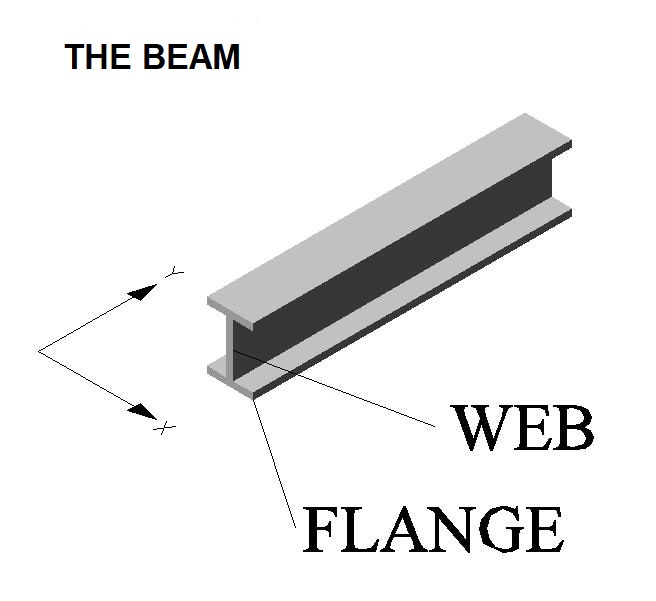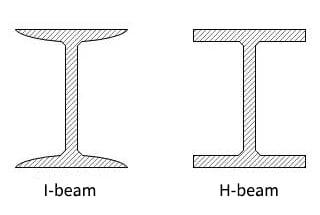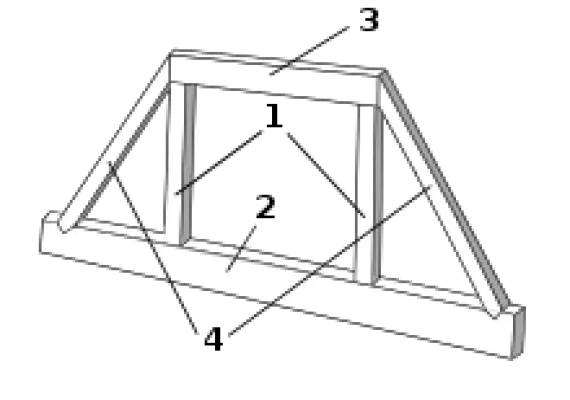Difference Between H Beam and I Beam |What is an H-Beam | What is an I-Beam
Difference Between H Beam and I Beam |What is an H-Beam | What is an I-Beam
What is an H-Beam?
An H-beam is a structural beam that is shaped like an H and gets its name because it looks like a capital H over its cross-section. H beam is made of rolled steel and incredibly strong.
Details about H Beam
- The web of the H beam is thicker and, therefore, more stronger.
- H beam flanges and the web have what is called a bevel, in which three pieces of metal come to join and, in the end, appear like a single piece of metal.
- It has a bottom and top flange that protrude further from the web when compared with the I -beam flanges.
- H-beam cross-section can bear the direct load and tensile stress and resist twisting as the cross-section is wide.
- H-beam is best for bridges, columns, mezzanines, beams, platforms, and for commercial and residential building structures.
- The flanges on an H-beam are longer and stick out further from the center web.
- H-beams can be built up to any size or height and can be used for spans up to 330 feet.
- When compared, H-beams weighed is higher than I-beams with the same specifications.
- Again, H-beams are built up rather than milled.
- The distance from the end of the H beam flange to the beam center web is longer on an H-beam when the same comparison is made on the I-beam flange.
What is an I-Beam?
An l -beam is a structural beam shaped like an I and consists of two horizontal planes called flanges that are connected by one vertical component called a web. These particular beams have tapered edges, and they get their names from the fact that it looks like a capital I when viewed from its cross-section. An I-beam has a higher height of the cross-section than the width of its flange.
Difference Between H Beam and I Beam / H Beam vs I Beam
|
|
H -Beam |
I-Beam |
| Weight and Load of Beam | The H-beam is often a lot heavier than the I-beam, which means it can take more force | With some buildings where weight and force on a wall may pose a structural issue, the I-beam may be better since it is often lighter. |
| Center Web of the Beam | An H-beam has a thicker center web, which means it is often stronger. | An I-beam often has a thinner center web, which means it is often not able to take as much force as an h-beam.
|
| Built-Up of Beam | An H-beam can possibly be built up which means it can be built up to any size or height. | An I-beam can only be built up as much as the manufacturer’s milling equipment allows. |
| Beam ‘s Span | H-beams can be used for spans up to 330 feet. | An I-beam may be used for spans of between 33 and 100 feet.
|
| Flanges of the Beam | H-beams have top and bottom flanges that stick out further from the web than the flanges on I-beams | I-beams have top and bottom flanges, and they are shorter and are not as wide as H-beams. |
| Mechanical Properties | H-beam steel is economical section steel with better mechanical properties in section than I-beam | Not economical when compared with H Beam |
| Stability | H Beam can be used as a load-bearing column, and it is stable.
|
I-beam alone cannot meet the stability demand because even thicken I-beams are unstable when used in load-bearing columns.
|
| Shape | Has an H Shape when viewed from the cross section | Has an I Shape when viewed from the cross section |
| Flange Lateral Stiffness | The flanges of hot-rolled H-beam steel is wider than that of I-beams, have greater lateral stiffness, and are more resistant to bending.
|
A narrow flange has less lateral stiffness with resistance to bending.
|
| Number of Pieces
|
The H-beam looks like one piece of metal, but it has a bevel where three pieces of metal come together.
|
An I-beam is not made by welding or riveting metal sheets together and is only one piece of metal throughout.
|
| Fabrication | The I-beam is fabricated by milling or rolling the steel. | The I-beam is fabricated by milling or rolling the steel |
| Uses | H-beam steel can be used for load-bearing columns.
|
I-beam can only be used for beams.
|
H-beams and I-beams are both types of structural steel beams used in construction. The main difference between them lies in their cross-sections. H-beams have a thicker web and parallel flanges, while I-beams have a thinner web and tapered flanges.
H-beams are better at carrying bending and shear loads due to their greater section modulus and tensile strength. They are often used as beams in construction. On the other hand, I-beams are more suited for support frames and columns.
They are lightweight and can withstand both tension and compression forces. H-beams are generally used for longer spans, while I-beams are used for shorter spans.
Overall, both beams have their own advantages and are commonly used in different construction applications.
Key Takeaways:
- H-beams have a thicker web and parallel flanges, while I-beams have a thinner web and tapered flanges
- H-beams are better at carrying bending and shear loads, while I-beams are more suited for support frames and columns
- H-beams are generally used for longer spans, while I-beams are used for shorter spans
Structural Steel Beams: H Beam vs I Beam Strength Comparison
When it comes to comparing the strength of H beams and I beams, their different cross-sections play a crucial role. H beams, with their thicker web and parallel flanges, possess greater strength to resist bending and twisting forces.
This is attributed to their higher moment of inertia and lateral stiffness, which make them highly resistant to bending.
On the other hand, I beams, with their thinner web, are less efficient in resisting bending compared to H beams. However, I beams still have the capacity to carry heavy loads and withstand both tension and compression forces.
The choice between H beams and I beams ultimately depends on the specific requirements of the construction project and the type of loads they need to support. H beams are typically more suitable for longer spans and heavier loads, while I beams are better suited for shorter spans and lighter loads.
It is important to carefully consider the design and aesthetic aspects of the structure as well. H beams offer a more optimized cross-section, providing superior mechanical properties that make them ideal for applications where greater strength is required.
Ultimately, the decision between H beams and I beams should also take into account factors such as cost and availability. H beams are generally more economical and readily available, making them a preferred choice in many construction projects.
On the other hand, the availability of certain sizes of I beams may be limited. When making the choice, it is crucial to assess and balance the load requirements, design preferences, and cost considerations to ensure the best fit for the construction project.
| Factors | H Beams | I Beams |
|---|---|---|
| Strength | High | Moderate |
| Efficiency in Resisting Bending | Excellent | Good |
| Span Capacity | Longer Spans | Shorter Spans |
| Load Capacity | Heavy Loads | Lighter Loads |
| Design Flexibility | Flexible | Less Flexible |
| Cost | Economical | Varies |
Applications of H Beams and I Beams in Construction
Structural steel beams, such as H beams and I beams, play a vital role in various construction applications. These beams offer unique characteristics and advantages that make them suitable for specific purposes. Let’s take a closer look at the applications of H beams and I beams in construction.
H Beams
H beams, also known as wide flange beams, are widely used as load-bearing columns in commercial buildings, platforms, and bridges. Their wide flanges and high strength make them ideal for supporting heavy vertical loads.
H beams can be built up to any size and height, providing flexibility in construction design. They are commonly used in large-span structures, such as warehouses and industrial buildings.
Additionally, H beams are commonly employed in the construction of mezzanine floors, where their ability to support heavy loads is crucial.
I Beams
I beams, also referred to as universal beams, are commonly used for support frames and columns in elevators, trailers, structural steel buildings, and bridges. Due to their lightweight nature, I beams are easy to install and transport, making them a popular choice in construction projects. They are versatile and can handle a range of loads, both tension and compression forces.
I beams are often utilized in structures that require added stability and strength, such as crane girders and trusses. Their tapered flanges provide excellent structural support, making them suitable for various applications.
Comparison Table
| Features | H Beams | I Beams |
|---|---|---|
| Web Thickness | Thicker | Thinner |
| Flange Thickness | Parallel flanges | Tapered flanges |
| Load Capacity | High | Moderate |
| Application | Load-bearing columns, platforms, bridges | Support frames, columns, elevators, trailers |
As shown in the comparison table, H beams are renowned for their higher load capacity and are suitable for heavy-duty applications.
On the other hand, I beams are more versatile and commonly used in various construction projects. The choice between H beams and I beams depends on specific project requirements, loads, and design considerations.
In summary, H beams and I beams are essential elements in construction, providing support, stability, and strength to various structures. Understanding their applications and characteristics is crucial in making informed decisions for construction projects.
Key Factors to Consider When Choosing Between H Beams and I Beams
When deciding between H beams and I beams for a construction project, there are several key factors to consider.
First and foremost, it is important to evaluate the specific load requirements of the structure. H beams are better suited for longer spans and heavy loads, making them a preferred choice for applications where greater strength is needed.
On the other hand, I beams are more suitable for shorter spans and lighter loads. By assessing the load demands, you can determine which type of beam will provide the necessary support.
Design and aesthetics are also important considerations. H beams have an optimized cross-section and offer superior mechanical properties, making them an ideal choice when greater strength is required.
I beams, while not as strong as H beams, are lightweight and offer versatility in their application. Depending on the design and aesthetic preferences of your project, you can choose the beam that best complements the overall look.
Lastly, cost and availability play a role in the decision-making process. H beams are generally more economical and readily accessible, making them a popular option for many construction projects. O
n the other hand, I beams may have certain size limitations, which could impact their availability. By taking cost and availability into account, you can make an informed decision that aligns with your project’s budget and timeline requirements.
FAQ
What is the difference between an H beam and an I beam?
The main difference lies in their cross-sections. H beams have a thicker web and parallel flanges, while I beams have a thinner web and tapered flanges.
Which type of beam is stronger, H beam or I beam?
H beams are better at carrying bending and shear loads due to their greater section modulus and tensile strength. However, I beams are still capable of carrying heavy loads and can withstand both tension and compression forces.
Where are H beams and I beams commonly used in construction?
H beams are commonly used as load-bearing columns in commercial buildings, platforms, and bridges. I beams are often used for support frames and columns in elevators, trailers, structural steel buildings, and bridges.
What factors should be considered when choosing between H beams and I beams?
Factors to consider include the specific load requirements of the structure, the design and aesthetics of the structure, and the cost and availability of the beams.




